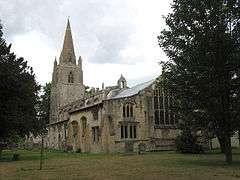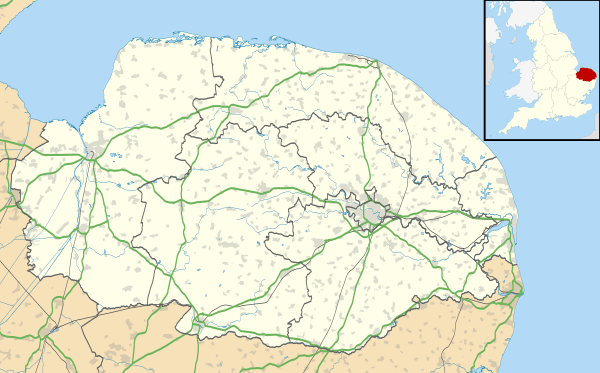Walsoken
Walsoken is a settlement and civil parish in Norfolk, England,[1] which is conjoined as a suburb at the northeast of the town of Wisbech, Cambridgeshire.
| Walsoken | |
|---|---|
 Parish church of All Saint, Walsoken, Norfolk | |
 Walsoken Location within Norfolk | |
| Area | 12.57 km2 (4.85 sq mi) |
| Population | 1,489 (parish, 2011 census) |
| • Density | 118/km2 (310/sq mi) |
| OS grid reference | TF4710 |
| • London | 103 miles (166 km) |
| Civil parish |
|
| District | |
| Shire county | |
| Region | |
| Country | England |
| Sovereign state | United Kingdom |
| Post town | WISBECH |
| Postcode district | PE13, PE14 |
| Dialling code | 01945 |
| Police | Norfolk |
| Fire | Norfolk |
| Ambulance | East of England |
| UK Parliament | |
The parish of Walsoken in the 2001 census, has a population of 1,484 rising slightly to 1,489 at the 2011 Census.[2] For the purposes of local government, the parish falls within the district of King's Lynn and West Norfolk.
History
The name Walsoken is thought to originate from the Old English meaning the district under particular jurisdiction by the wall[3] which refers to the villages proximity to a Roman sea wall or defence.
Roman settlement
Archaeological evidence has found that much of the land of Walsoken of pre-Roman occupation was completely submerged beneath the Iron Age silts. As such, very little early prehistoric archaeology has been recorded. It is thought that some dry land existed within the parish in the Bronze Age as several artefacts from that time period were uncovered in the 19th century.[4] There has been a lot more archaeological evidence found to attest to Roman occupation in the parish, including a dispersed hoard of 300 to 400 Roman coins, mostly of Postumus, but including examples minted by Gallienus and Hostilian which were found via metal detecting in the 1980s.[5]
Medieval period
Ailwin (or Aethelwine), earl of East Anglia, gave 5 hides at Walsoken to Ramsey Abbey. The principal manor of Walsoken was Popenhoe and originally belonged to Ramsey Abbey.[6]
The settlement's population, land ownership and productive resources were detailed in its entry in the Domesday Book of 1085.[7] In the great book Walsoken is recorded by the name 'Walsocam', which was held by the Benedictine Order based at Ramsey Abbey before and after 1066. The survey also records the presence of a fishery.
In 1286 Desiderata grand-daughter of Sir Stephen de Maresco, Lord of Newton, Walsoken and Tidd St Giles married Sir Roger de Colvile.[8]
There was Guild of the Assumption of our Lady, a Guild of St Thomas the Martyr, a Guild of the Nativity of our Lady, a Guild of St John and a Guild of the Trinity according to the will of Thomas Honiter (1513).[9]
Amalgamation with Wisbech
The county boundary between Norfolk and the Isle of Ely based on the old course of the Welle Stream through the built-up area, dividing up roads and streets haphazardly. Wisbech and Walsoken were amalgamated in April 1934 – a boundary marker stone in Wisbech Park records the event and bears the names - Joseph Smith, Mayor of Wisbech and Thomas Burling, Warden of Walsoken. Part of the ecclesiastical parish was transferred to the Isle of Ely from Norfolk. As a result the church remains in Norfolk and the village hall, cemetery, schools and most shops are now in the New Walsoken part of Wisbech.[10]
Geography
The village and parish of Walsoken is situated in the west of Norfolk on the border with Cambridgeshire – most of the original village now lies in Cambridgeshire but All Saints Church lies in Norfolk.[11]

The village is a suburb of the fenland town of Wisbech and its ancient character and historic core have been surrounded by modern housing.[12] The parish is south of West Walton, north of Emneth and west of Marshland St James.
Walsoken is approximately 47 miles (80 km) west-north-west of Norwich, 11 miles (20 km) west-south-west of King's Lynn and 80 miles (100 km) north of London. The suburb and parish is 1 mile (1.6 km) east-north-east of the centre of Wisbech. Walsoken is to the east of the B198 which was the old A47 renumbered in 1984 with the opening of the Wisbech bypass.[13]
The nearest railway station is at Downham Market for the Fen Line which runs between King's Lynn and Cambridge. The nearest airport is Cambridge International Airport.
Landmarks
All Saints Parish Church
All Saints' Church in Walsoken is a Grade I listed building and consists of a nave with south and north aisles, chancel with south and north chapels, south porch The nave and chancel are both late Norman and date from c.1146.[14] Above the chancel arch is a 15th-century carving of King David with harp. This church is crowned by a prominent west tower with four turrets and a spire which dates from the medieval period.[15] To the base of the tower is the rounded Norman west doorway. The interior of the church has massive Norman arcades which are rich with zigzag moulding decoration. An arch in the chancel is supported on carved banded shafts. On one side is the 15th-century doorway to the old rood loft. The nave roof has painted angels and other figures in delicately canopied niches. There are 15th-century[14] screens in both aisles, one with most intricate tracery, stalls with carved heads, battered figures on old benches, and over the tower arch two paintings of the judgement of Solomon with a statue of a king enthroned between them. The Seven Sacrament font is 400 years plus old.[15] This pre-Reformation font is decorated with sculptures of the crucifixion and seven sacraments (these are; Baptism, Confession, Confirmation, Last Rites, Mass, Matrimony and Ordination), eight saints under rich canopies (these are; Catherine, Paul, John, Magdala, Steven, Margaret, Peter and Dorothea), and round the base this inscription to those friends of the church who gave it: "Remember the souls of S. Honyter and Margaret his wife, and John Benforth, Chaplain 1544".[15]
One child baptised at this font grew up to be archbishop of Canterbury. He was the Rector's boy, Thomas Herring, who became archbishop in 1747,[15] and a little while before he died put a tablet in the chancel here "in grateful memory of his excellent parents". He was a man of immense enthusiasm and full of generosity. There are several later window insertions throughout. The church's bell tower has six bells made by Thomas Osborn in Downham Market in 1795. Originally the bells were hung in a frame adjacent to the louvres in the tower. The bells were restored and re-hung in 1901 by the children of Richard Young, M.P. for Cambridgeshire, and further work was undertaken in 1956 when the bells were re-hung in a lower position in the tower in an eight bell metal frame. This was to allow for the future provision of two additional bells, which has not to date been achieved.
Notable People
Names are in birth order. Data are from the subject's Wikipedia article except where referenced.
- Thomas Herring M.A., (1693-1757) Archbishop of Canterbury from 1747-1757. Born in Walsoken and died 23 March 1757. Attended Wisbech Grammar School
- Robert Goodale, (1840-1885) was executed in Norwich Castle in December 1885 for the murder of his wife Bathsheba, on 15 September 1885. To the horror of all present, the hanging resulted in the decapitation of the condemned prisoner.[16]
Sport
A short lived greyhound racing track called the Wheatley Bank Sports Stadium existed between 1947 and 1948. The racing was independent (not affiliated to the sports governing body the National Greyhound Racing Club) and was known as a flapping track, which was the nickname given to independent tracks.[17] The track could only accommodate 500 spectators and is reported to have reopened on 10 July 1948 meaning it had closed at some stage after 1947. Races were over 350 yards and meetings were held three times per week.[18]
References
- OS Explorer Map 235(2006) – Wisbech & Peterborough North, Market Deeping & Crowland. ISBN 0-319-23807-5
- "Parish population 2015". Retrieved 30 August 2015.
- A Popular Guide to Norfolk Place-names: by James Rye: Published by Larks press, Dereham, Norfolk, 2000 ; ISBN 0-948400-15-3
- "Walsoken". www.heritage.norfolk.gov.uk. Retrieved 13 January 2019.
- "Norfolk Heritage Explorer". www.heritage.norfolk.gov.uk. Retrieved 13 January 2019.
- F.J.Gardiner (1898). History of Wisbech and Neighbourhood. Gardiner & Co.
- The Domesday Book, Englands Heritage, Then and Now, Editor: Thomas Hinde, Norfolk page 196, Walsoken, ISBN 1-85833-440-3
- F.J.Gardiner (1898). History of Neighbourhood. Gardiner & Co.
- "Walsoken". www.british-history.ac.uk. Retrieved 12 January 2019.
- "schools". www.british-history.ac.uk. Retrieved 12 January 2019.
- "About All Saints' Church, in Walsoken". All Saints, Walsoken. Retrieved 6 May 2015.
- "1500 homes". www.wisbechstandard.co.uk. Retrieved 13 January 2019.
- County A to Z Atlas, Street & Road maps Norfolk, page 230 ISBN 978-1-84348-614-5
- Norfolk 2: Norfolk: North-west and South, By Nikolaus Pevsner and Bill Wilson, Walsoken entry. 0-300-09657-7
- The King's England series, NORFOLK, by Arthur Mee, Pub: Hodder and Stoughton, 1972, page 323/324, Walsoken, ISBN 0-340-15061-0
- "Lincolnshire Chronicle". www.britishnewspaperarchive.co.uk. Retrieved 20 October 2019.
- Barnes, Julia (1988). Daily Mirror Greyhound Fact File, page 419. Ringpress Books. ISBN 0-948955-15-5.
- "WALSOKEN (Wheatley Bank)". Greyhound Racing Times.
External links



